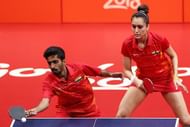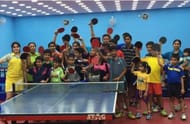Recently, Sportskeeda journalists attended the Delhi leg of Ultimate Table Tennis (UTT) and got the opportunity to interact with the CEO of The International Table Tennis Federation (ITTF) -- Steve Dainton. Here we discuss with him the future plans of the Federation, the recent changes ITTF has made and the prospect of the sport in India.
Steve is a die-hard enthusiast of the game and was ecstatic on his visit to India, gladly addressing all the questions of Media representatives.
Sounding confident, Steve proudly calls themselves as the "New ITTF," as they have a new team, a new management, and a changed outlook.
Following are the excerpts from the interaction:
Q. ITTF recently introduced a new ranking system. What was the idea behind that and how do you plan to implement it to engage more people?
Steve: Well, I think it a commercial question and simple as well. We needed a ranking which supported our products, which are major events. Previously, we had a philosophy which was providing the ranking on a technical level but it did not necessarily support our product because the former ranking meant that one did not really have to play all the events. One could simply participate in the events in which they desired and I do not think that helped us in building the commercial product and increasing competitiveness in the sport.
When you are trying to build a commercial product, you need the best of players at the best events and you can't have excuses for that. You can not say that because of some vague reason, the player decided not to play. Be it our World Tour Events or World Championships or World Cups, we need them there.
The broadcaster wants the best players, the sponsors want the best players and the new world ranking encourages the crème de la crème to play at the best events. We are seeing it work as well.
The new ranking system also received a lot of criticism in the beginning -- as those countries and higher ranked players that were not prepared for it, obviously dropped back in ranking. However, if they keep playing and achieving results, the order will be restored.
Q. What do you feel about development of Table Tennis in India?
Steve: India has the 2nd largest population in the World, and Table Tennis is a relatively popular sport here. If the market is to grow in India, then we need more top-class players playing at the highest level. I believe three gold medals at the Commonwealth Games (CWG) is a brilliant start, taking the imagination of the sport to the wider population.
Q. Tennis and badminton are vastly more popular sports and garner more followers. What do you think they do well which the Table Tennis federations have failed to do so far?
Steve: In my personal opinion, in the 1960s when television became a key part of how sports is presented around the world, we didn't take the necessary steps that time to move on the new trend. However, we are catching up now in this new age of Social media. I believe Table Tennis is an extremely viewer-friendly sport and will gradually pick up like tennis and badminton.

Q. The consumption of the sport has definitely increased in India post the CWG. Do you think India are the emerging dark horses in the sport?
Steve: Yes, that is a 100% correct. With Ultimate Table Tennis providing the much-needed exposure to the players, clubbed with high-performance programmes with International coaches, the Indians have been on a roll. The head-coach Massimo Costantini has done exceptionally well to improve the performance of the national teams manifold.
Of course, the two Indian players I have been observing closely are Manika Batra, who became a household name after CWG; and Sathiyan Gyanasekaran -- who I feel is immensely talented and also creative in the way he plays. They both are still young, and who knows where participation in a few more international events may take them.
Q. Where do you see UTT five years down the line?
Steve: I really hope that it grows, and we will also work with the Table Tennis Federation of India (TTFI) and UTT to see if more International events can take place in India. However, UTT is still two years old, and to be able to execute an event of such a magnitude is a truly commendable feat. The level of players who are coming in is pretty good, it is maybe not your Ma Long's but its just behind and that is amazing. The level of production and management is simply superb and UTT deserves credit for this.
Q. What is the probability of having a World Cup or a Championship here in India?
Steve: We changed the complete philosophy of Championships. From having to ask local federations to send in contingents, Championships have become a mega-event in which the countries must qualify for in order to take part in. There are a lot of stages which the nation must go through before getting to the final.
There have been structural changes as well, allowing us to talk to various countries who would earlier not have hosted the Championships -- just because of the system, structure, size, and the logistics involved. We have already had serious discussions for 2021 and 2022.
The good thing for ITTF is that -- earlier only one or two countries bid to host the Championships, and now that number has risen to 21.
There is a lot of activity in the sport in India with regional and national tournaments being organized. However, even though the underbelly of the sport has the product, the sales aspect is missing. This is a great chance to sit at the top and get the visibility of the sport by doing an analysis.
If there is international participation, national events, UTT -- all combined form a serious product which can then be taken to the TV broadcasters, and the media.
Q. Besides being late starters, Badminton World Federation (BWF) has categorized more events and is doing really well with rapid commercial growth. Where it is that you think ITTF lacks?
Steve: This is something we have studied a lot. When I started off in marketing in 2005, I watched their growth and ours simultaneously. Between 2000-05 they were having their own political problems. However, a change in management was there which built a really strong commercial structure. We also did a lot between 2000-05 but stayed stagnant for too long after that.
If we want to grow then it is all about the commercial revenue -- If that is good we can put it back in the development by ensuring good prize money.

Q. What are the steps which you have taken so far to ensure that ITTF is seen as an organization which is seriously looking at the commercial aspects.
Steve: It may sound stupid, but the truth in that this was the first time we introduced a strategic plan (properly documented) right before the World Championships in Halmstad. Prior to that, we had a plan but it was not well documented and not very transparent.
If you were to ask the strategic plan to every person in the organization about a year back, you would have gotten a different answer from each. However, the plan is there now -- clearly documented -- and states the 55 things that we want to achieve in the next 6 years. It is a whole range of things we want to achieve - from the commercial to the developmental, to Federation aspects. It is ambitious but it there. I feel that the way World Championships were conducted in Halmstad is a huge success for the plan.
The new model of World Championships is a commercial-based idea. We had a model before 2012 wherein every member could participate if they wanted to. This was a very family oriented socialist philosophy. However, the philosophy now is that if you want to make it to the Finals, you need to be really good. This would really drive the development of the sport. It changed from "No matter how good I am, I still play the World Championships" to "I need to be good to be able to go to the finals." This will really drive the other countries to improve the skill levels.
Q. The FIFA World Cup is one of the best-managed events. How influenced are you by the 'Greatest Show on Earth' and its philosophy of keeping it down to 32 teams?
Steve: I have been influenced by the FIFA World Cup for the past 30 years, watching how amazing it is and how it has gone from strength to strength. Obviously, it can be an argument as to what they have been doing right. Is it that people like football more than Table Tennis? However, I do believe that the structure that they have helps them achieve those results.
We lack in the manpower right now and have plans to grow people in the Operations department to fulfill our goals. We just get overwhelmed sometimes, as we are just a staff of 30 people trying to manage Table Tennis globally. Our Media team initially just consisted of 1 person (me) and now we have 7-8 working in Singapore.
The reality is that in a sport which has one country winning the majority of the tournaments every time, it becomes difficult to engage the sport outside of that one. We try our best to capitalize on the Chinese market, but if we only do that we will soon be looking for new jobs ourselves.
We do not want to put barriers for China to be successful, but the goal is that other countries catch up and give them competition.
Author's take:
Ultimate Table Tennis may have concluded now and all the jazz died down a little. However, the 2018 Korea Open is currently underway and it is the seventh event of the 2018 ITTF World Tour. India's overnight sensation (thanks to her achievements at the 2018 Gold Coast) Manika Batra will be seen in action alongside Sathiyan Gyanasekaran in Mixed Doubles and Mouma Das in Women's doubles, respectively.
Sources also tell us that India is interested in hosting the World Championships as well. If that is to happen, firstly -- India will automatically qualify as hosts. However, the problem arises as India has the infrastructure to host 32 teams, but not over 70 teams.
ITTF has also been pivotal in giving the necessary guidance and push to the National Federation (TTFI) for the future events.
There were talks about a league a long time back. It is great to see the league (Ultimate Table Tennis) finally coming to life two years back. From what has been observed, the response has also been exceptional. There are even a few international brands keen to look at the Indian Table Tennis market. As the commercial business grows, not only UTT but also Table Tennis, on the whole, will prosper and the situation will naturally change over time. Table Tennis is bound to become more professional and holds a bright future in India.
